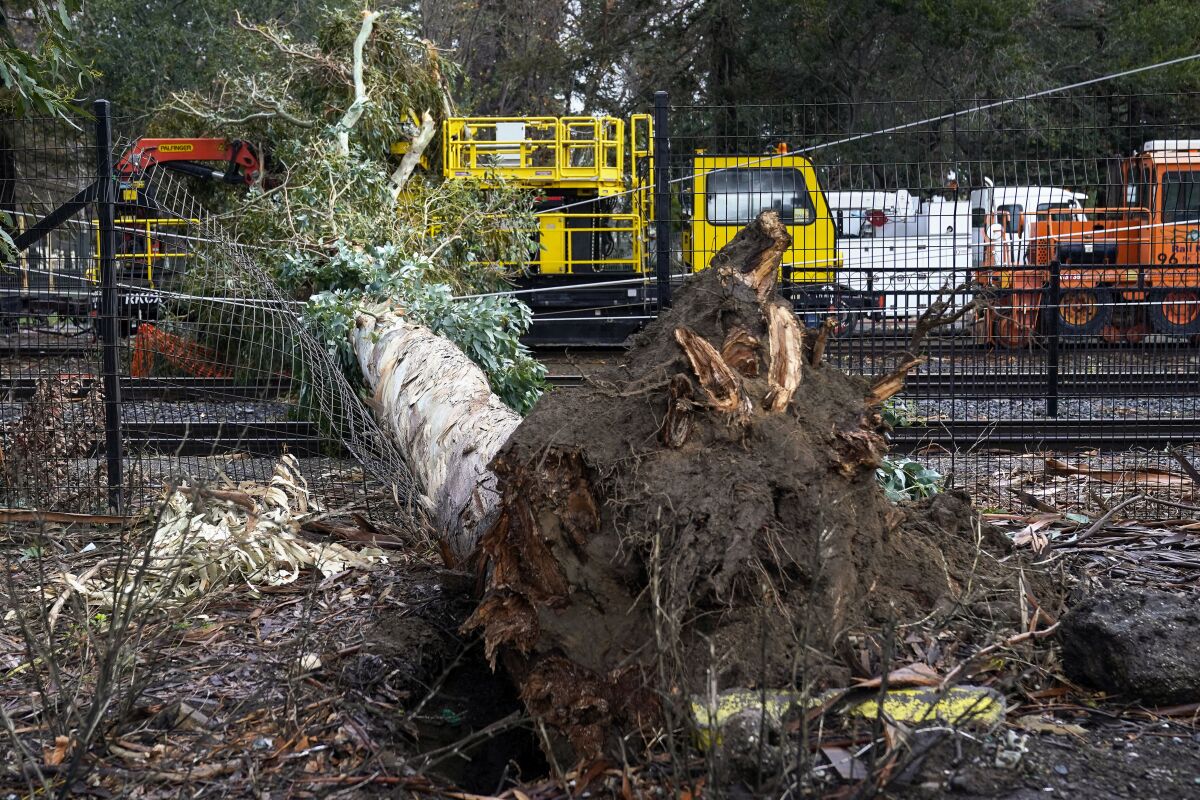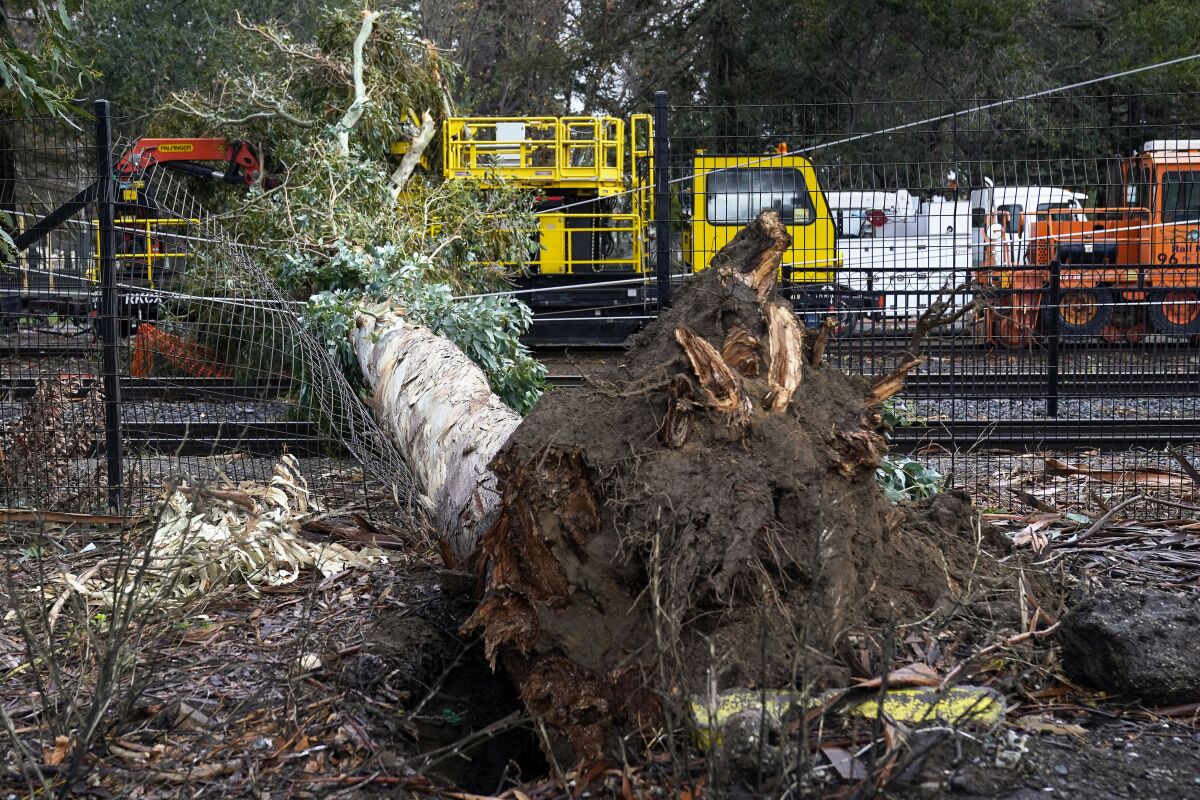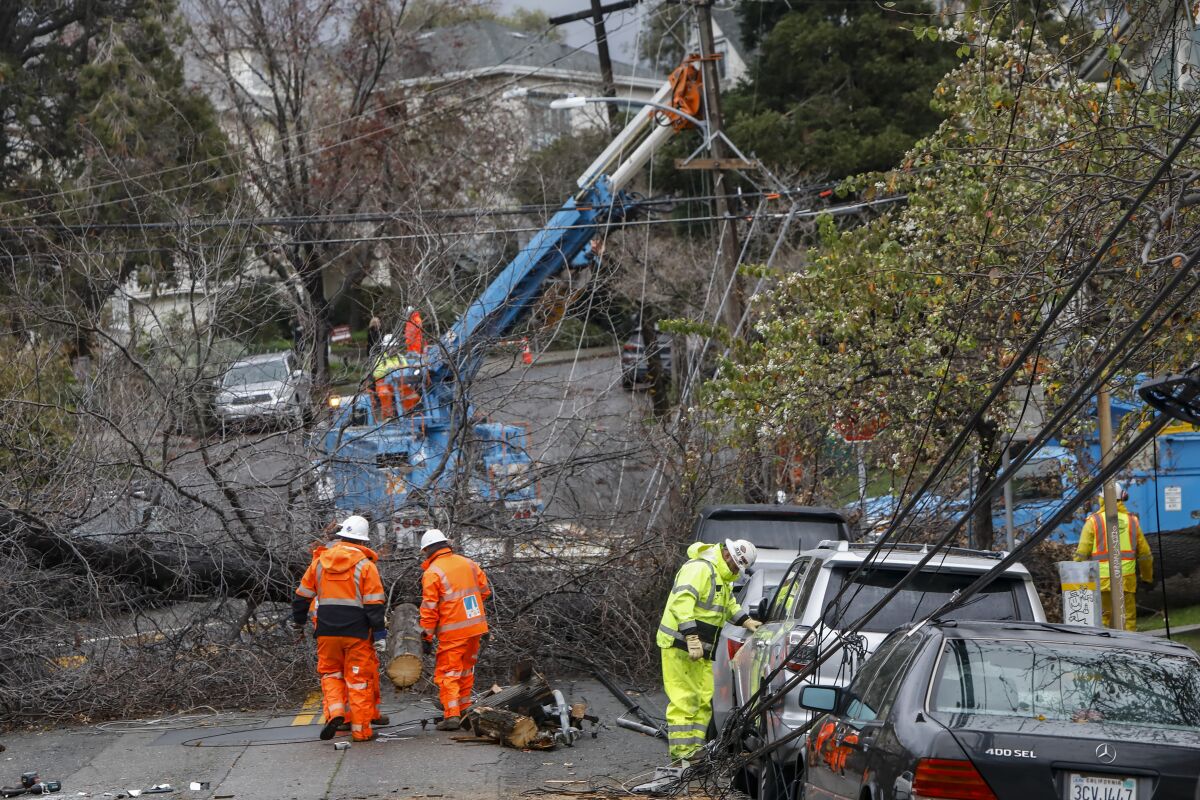 [ad_1]
[ad_1]
David Higares was on his fourth day with out energy in his Morada residence in San Joaquin County when he woke as much as indoor temperatures barely above 50 levels.
His lights had flickered twice since his neighborhood outdoors Stockton went darkish Saturday, following one of many practice of atmospheric river storms, however his residence remained darkish, he mentioned. Every time he checked, it appeared Pacific Fuel & Electrical had once more pushed again the estimate for restoring energy.
“It feels countless at this level,” mentioned Higares, who misplaced all of the meals in his fridge and freezer as a consequence of spoilage. “Mainly, we’re tenting indoors.”
Since New Yr’s Eve, lots of of hundreds of Californians have misplaced energy — many a number of occasions — as a string of extreme winter storms has offered the most recent glimpse into how excessive climate tied to local weather change is difficult California’s energy grid in unprecedented methods.
Elevated stress on the electrical grid has beforehand been most obvious in the summertime and fall months, when wildfires have compelled shutoffs to keep away from strains sparking flames and through excessive warmth when officers have requested clients restrict energy use throughout peak occasions.
However this highly effective string of storms wreaked a brand new type of havoc for utility suppliers, with heavy rains and excessive winds pummeling drought-stressed land, toppling timber onto energy strains, flattening help poles and blocking entry to sure areas. At one level, greater than 400,000 had been with out electrical energy, the overwhelming majority in Northern California. For some, getting energy again was a days-long ordeal. Others mentioned they felt as in the event that they had been caught in a cycle of shedding and regaining energy.
“We count on, sadly, extra climate extremes, extra local weather volatility — not simply hotter in the summertime, however extra excessive climate in our winters,” mentioned Mark Toney, government director of the Utility Reform Community, which advocates on behalf of utility ratepayers. “Utilities [should be] viewing themselves as a part of an ecosystem, if you'll, of catastrophe preparedness.”
Because the state seems to be for choices to strengthen its energy grid within the face of those extra highly effective storms, officers are operating into among the similar challenges as when responding to excessive warmth or hearth risks.

A tree toppled by excessive winds broken energy strains and obstructed Caltrain tracks in Burlingame on Jan. 5.
(Godofredo A. Vásquez / Related Press)
Choices to make the ability grid extra resilient stay restricted, and in lots of circumstances, include a hefty price ticket — a priority for Californians already going through among the highest electrical energy prices within the nation.
“That is type of the brand new regular, that is type of what the local weather disaster has introduced us,” mentioned Ric O’Connell, government director of GridLab, a nonprofit centered on energy grid transformation. He mentioned California officers and utilities needs to be “considering holistically concerning the system,” contemplating new expertise and progressive methods that may present extra resilient power sources even throughout crises.
PG&E, the state’s largest electrical energy supplier, has plans to bury hundreds of miles of strains to higher defend towards wildfires, which might additionally assist eradicate danger from excessive winds or falling timber, specialists mentioned — nevertheless it’s one of many costliest options. The plan is anticipated to price no less than $15 billion, and it solely accounts for about 10% of PG&E’s transmission and distribution strains. Transferring all of the state’s energy strains underground can be financially unsustainable, O’Connell mentioned.
“It could actually price trillions of dollars, so possibly that’s not the perfect strategy,” O’Connell mentioned, particularly given the huge price estimated for harm and restoration from this sequence of winter storms.
O’Connell pointed to different backup energy choices that would improve resiliency, equivalent to leveraging inexperienced power applied sciences, growing native battery storage, forming extra microgrids that function individually and making higher plans for a way essentially the most susceptible can entry energy when the grid fails.
Given at present’s local weather patterns — swinging from excessive drought to excessive rains — it’s onerous for grid operators and planners to adapt, and accomplish that quick sufficient, mentioned Sascha von Meier, a retired UC Berkeley professor now a guide who focuses on electrical grids.
“These should not situations that the system was designed for or engineered for,” Von Meier mentioned, which is why she wish to see extra outside-the-box power planning, particularly centered on renewables, their storage and transmission.
“We’re radical, greater image” concepts, Von Meier mentioned. “If we do it proper, we’re going to construct a number of extra capability of photo voltaic and wind technology.”
O’Connell pointed to initiatives such because the Blue Lake Rancheria tribe’s neighborhood microgrid that gives cleaner and extra resilient power for its rural neighborhood in Humboldt County, which is understood for storms, earthquakes and fires.
A few of California’s utility suppliers have explored microgrid choices, particularly in distant areas, however O’Connell mentioned there’s a necessity for extra, particularly when the grid is beneath nearly fixed stress.
Earlier than the most recent storms, PG&E, Southern California Edison and different utilities labored to attenuate harm by tree-trimming and pre-positioning gear and manpower in several areas based mostly on forecasts, even calling in additional crews from out of state.
However the severity and length of the storms meant there can be outages, specialists mentioned.
“We’ll need to take care of the mud settles with this specific sequence of storms to see how effectively these preparations labored,” mentioned Peter Larsen, the chief of the Electrical energy Markets and Coverage Division on the Lawrence Berkeley Nationwide Laboratory. “The query is, had been these preparations ample, given what’s occurring proper now? ... The extent of the ability disruption is fairly widespread.”
Seven consecutive atmospheric river storms have slammed the state since Christmas; first knocking out energy for no less than 100,000 on New Yr’s Eve, principally within the Sacramento space, then days later 170,000 had been with out energy following an evening of significantly sturdy winds in Northern and Central California, which PG&E officers on the time known as “some of the highly effective storms in current reminiscence.”
Then Saturday, a fair stronger storm left greater than 400,000 with out energy statewide, with outages spanning dozens of counties from Humboldt to Los Angeles, in coastal cities up into the jap Sierra.
Many Californians misplaced electrical energy a number of occasions; some discovered themselves with out energy for as much as every week.
On Thursday, about 30,000 had been nonetheless ready for the lights to return again on, in response to an on-line energy outage tracker.

Utility employees from Pacific Fuel & Electrical clear a fallen tree, which took down some energy strains subsequent to Bella Vista Elementary Faculty in Oakland earlier this month.
(Salgu Wissmath / Related Press)
After three days with out energy throughout this newest storm sequence, Davis resident Richard McCann mentioned he’s significantly contemplating implementing his personal microgrid so he doesn’t need to depend on PG&E.
“I’ve been interested by it,” he mentioned. McCann, whose work focuses on energy sector evaluation, mentioned his residence misplaced energy for about 48 hours starting New Yr’s Eve, then misplaced it once more after Saturday for about 12 hours.
Whereas the storms had been extreme throughout the state, McCann mentioned Davis didn't see unprecedented winds or flooding, including to his considerations concerning the grid’s reliability.
He mentioned he wish to see California’s utilities “distributing the system, so folks could be extra unbiased.”
“I believe that’s in all probability a greater answer fairly than making an attempt to construct up stronger and stronger partitions round a centralized grid,” McCann mentioned.
For years, “hardening” the ability grid has been the go-to answer for utilities — burying wires, strengthening and changing poles, including backup mills or changing older gear — however some electrical grid specialists mentioned these efforts are sometimes restricted by money and time.
Toney mentioned he expects the California Public Utilities Fee — the state’s regulatory and oversight board — to analyze the utility suppliers after these storms, trying on the extent and size of outages and guaranteeing that any worth will increase are vital.
The fee mentioned in an announcement it has been “monitoring the scenario” however didn't reply questions on a potential investigation.
Higares, in San Joaquin County, mentioned his energy was finally restored Wednesday afternoon, as PG&E’s huge restoration effort continued throughout the area.
He ended up shopping for a small generator because the outage dragged on, which might preserve the fridge chilly and supply just a few shops for charging electronics, he mentioned, however with out capability for warmth or different giant home equipment.
He’s hopeful the following storms — which forecasters warned might carry extra points this weekend — gained’t imply extra outages, however his expectations are low.
“I’ll get pleasure from a heat home whereas I can,” he mentioned. “There’s lots of people which are in approach worse conditions than me ... nevertheless it’s irritating.”
[ad_2]
Supply hyperlink https://classifiedsmarketing.com/?p=20893&feed_id=76727


